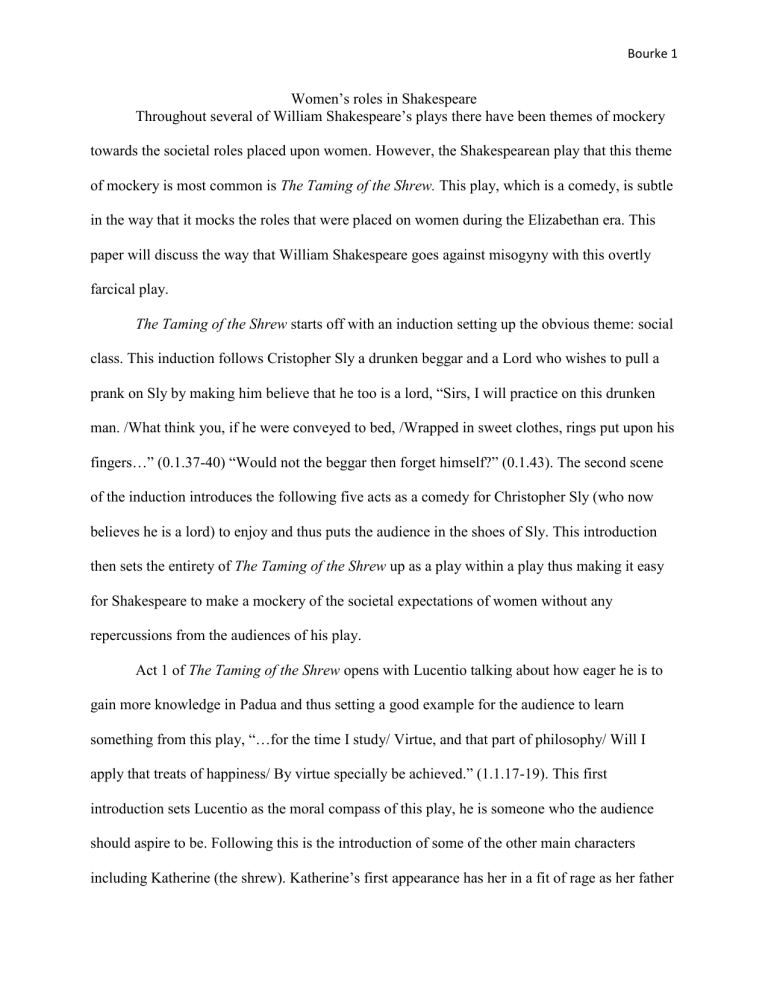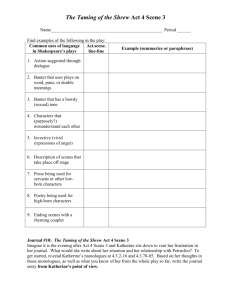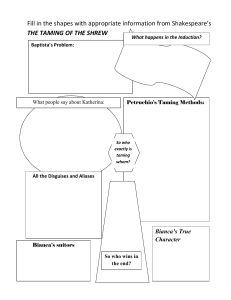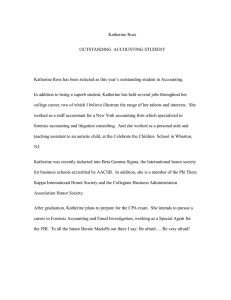
Bourke 1 Women’s roles in Shakespeare Throughout several of William Shakespeare’s plays there have been themes of mockery towards the societal roles placed upon women. However, the Shakespearean play that this theme of mockery is most common is The Taming of the Shrew. This play, which is a comedy, is subtle in the way that it mocks the roles that were placed on women during the Elizabethan era. This paper will discuss the way that William Shakespeare goes against misogyny with this overtly farcical play. The Taming of the Shrew starts off with an induction setting up the obvious theme: social class. This induction follows Cristopher Sly a drunken beggar and a Lord who wishes to pull a prank on Sly by making him believe that he too is a lord, “Sirs, I will practice on this drunken man. /What think you, if he were conveyed to bed, /Wrapped in sweet clothes, rings put upon his fingers…” (0.1.37-40) “Would not the beggar then forget himself?” (0.1.43). The second scene of the induction introduces the following five acts as a comedy for Christopher Sly (who now believes he is a lord) to enjoy and thus puts the audience in the shoes of Sly. This introduction then sets the entirety of The Taming of the Shrew up as a play within a play thus making it easy for Shakespeare to make a mockery of the societal expectations of women without any repercussions from the audiences of his play. Act 1 of The Taming of the Shrew opens with Lucentio talking about how eager he is to gain more knowledge in Padua and thus setting a good example for the audience to learn something from this play, “…for the time I study/ Virtue, and that part of philosophy/ Will I apply that treats of happiness/ By virtue specially be achieved.” (1.1.17-19). This first introduction sets Lucentio as the moral compass of this play, he is someone who the audience should aspire to be. Following this is the introduction of some of the other main characters including Katherine (the shrew). Katherine’s first appearance has her in a fit of rage as her father Bourke 2 is trying to make her marry men whom she does not want to marry. “[To Baptista] I pray you, sir, is it your will/ To make a stale of me amongst these mates?” (1.1.57-58). As this is Katherines first sentence it starts by making her appear to have more power than even her own father. However, Hortensio has a quick reply ““Mates,” maid? How mean you that? No mates for/ you, /Unless you were of gentler, milder mold.” (1.1.59-61). Hortensio is taking the standpoint that a majority of people during the Elizabethan would have taken. Women were property owned by their fathers until the father chose to pass them off to their husbands and women were expected to act like property. Since Katherine is not of a “milder mold” and behaves to standards that Hortensio does not approve of she is automatically in the wrong. This type of fighting continues through the first scene until Baptista decides that no one will marry his younger daughter Bianca until his elder daughter Katherine is married. Essentially trying to get rid of his older piece of property before his younger one. This starts the scheming of Lucentio, Tranio, Hortensio and Gremio to try and get the better mannered daughters’ hand in marriage because that is what men want. In Act 1 Scene 2 Petruchio is introduced. Petruchio is the tamer of the shrew that intends to make Katherine his well-behaved wife. Petruchio does this not out of love but for his need of money “I come to wive it healthily in Padua; If wealthily, then happily in Padua.” (1.2.76-77). Unfortunately for Katherine this means that she will in fact be wed to this misogynistic man who lusts for money who is cunning enough to “break” her. Act 2 starts with Katherine seemingly jealous of the attention that Bianca is getting from some of the men. Katherine says to Bianca “Minion, thou liest. Is’t not Hortensio?” (2.1.13) when she is talking about who Bianca likes the most out of Katherines suitors. This makes Katherine seem like she does in fact want to marry someone but from her interaction with Baptista in the previous scene she does not think that any of the suitors are good enough for her. Bourke 3 Katherine appears to want the attention that her younger sister gets but she is too strong willed of a woman to get the attention that she so yearns for. After this Petruchio goes to Baptista and asks if he has a daughter named “Katherina.” This misnaming that Petruchio does to Katherine continues through the play to demean her and starts the breaking process. Petruchio finally settles on calling her Kate. By shortening Katherine to Kate Petruchio is getting rid of the true meaning of the name Katherine which means pure. As act 2 scene 1 continues it is finalized by Baptista that Katherine will marry Petruchio, and Bianco will marry Lucentio. Bianca who seems to be the example of what a woman should be gets the virtuous man and Katherine the shrew gets a man who seems to be the most problematic and only trying to wed her for her wealth. This interaction is the one that ends the act. In act 4 of this play Petruchio’s taming of Katherine intensifies. Petruchio pretends to be the good guy but is secretly starving Katherine and making her sleep deprived “Tis burnt and so is all the meat.” (4.1.149). All of this does seem to cause Katherine to break or at least give in and do as Petruchio wishes. Act 4 seems to be the turning point of this play from having a strong woman to having one that follows all her husband’s wishes. However, despite act 4 being the turning point act 5 is perhaps the most important. The speech that Katherine gives towards the end of the play is the most ironic speech and gives a very strong message to the audience and to the readers. The now “tamed” Katherine’s speech goes as follows: “A woman moved is like a fountain troubled,/ Muddy, ill-seeming, thick, bereft of beauty,/ And while it is so, none so dry or thirsty/ Will deign to sip or touch one drop of it./ Thy husband is thy lord, thy life, thy keeper,/ Thy head, thy sovereign, one that cares for thee,...I am ashamed that women are so simple/ To offer war where they should kneel for peace,/” Bourke 4 This speech is about how women should behave according to their husband’s or Father’s wishes. Today this could easily be portrayed as a very sarcastic or snarky way that would make the audience see Katherine’s point in an unliteral way. This portrayal is one that would be more of a 21st century portrayal and not an Elizabethan portrayal. However, this would get a similar point across to the audience. As the induction leads the audience to believe this is a play within a play. With this in mind it is important to note that during the Elizabethan era it would mean that a man was playing the women. Thus, with a play within a play it would be a man playing a man who is playing Katherine. This causes the speech above to give off a completely different tone. Instead of this being a woman telling women how they should behave it is in fact reflecting society and the way that men are the ones telling women how to behave. To support this idea, Ela İPEK GÜNDÜZ, seems to believe that the farcical manner of The Taming the Shrew also plays a strong role in the way that this play is received by the audience stating: “Shakespeare uses some elements of farce intersected with the verbal comedy of the play. The misogynistic subject matter of the play is carried to the stage especially through the farcical behaviours of the actors.” (4). This means that the exaggerated manners of the actors would also help to play a role in making a mockery of the gender norms and the way that society viewed the roles of women. GÜNDÜZ continues saying “Only through disguises practised by changing of the clothes, the marginalised characters find the opportunity to reach the social roles they want to perform. Both identities and gender perceptions in the society depend on other people’s positioning individuals.” (4). This is made clear by the induction when Sly is tricked by a Lord that he too in fact is a lord. Through clothing characters seem to be marginalized or privileged. Katherine and the other women are marginalized in this play as well even though they are being played by men that are just dressed in what would be considered women’s clothing. A Bourke 5 very interesting point that GÜNDÜZ brings up is the idea that Katherine is marginalized in the same way that Christopher Sly is marginalized and that Sly’s forgotten identity at the beginning is in fact foreshadowing to Katherine’s loss of identity at the end of the play. (GÜNDÜZ, 4-5). Also noted by GÜNDÜZ both Katherine and Bianca remained opposites, the heavily desired Bianca became more shrewish while Katherine became the tamed one which is interesting because Lucentio and Bianca seem to have a better marriage than that of Petruchio and Katherine. Lucentio and Bianca have a relationship that seems to be built out of a mutual desire for one another and as discussed earlier Lucentio and Bianca seem to be the good guys in this play. They are both well-mannered and Lucentio is virtuous yet this act of Katherine being tamed, and Bianca not being tamed seems to show that one does not need a tamed wife to have a happy marriage. The idea that Katherine is just disguised like Sly seems to be something that author Wayne A. Rebhorn seems to think as well. Rebhorn states that Katherine is not actually tamed and that as suggested early in the play “Petruchio will “throw a figure” in Katherine’s face and thereby “disfigure” her” and “…that she will “lose face”” (Rebhorn, 34). Rebhorn continues stating that during this time period this means Katherine would not in fact be tamed but be disguised. This means that this intends to make a mockery of how husbands might believe they can tame their wives but actually cannot. It could also be a mockery of how easily it is to disguise oneself and make someone believe one is who they are not. When analyzing the rhetoric of this play Rebhorn concludes that the rhetoric used by men in this play is an “invincible powerful weapon” but is also a “just as potent defensive weapon” that is used by Katherine. (Rebhorn, 30). Through making a mockery of women’s roles this play could also serve as an example to women on how to defend themselves from the sort of rhetoric that men could be Bourke 6 using. Ultimately making this play a powerful tool for anyone who can pick up on these subtleties whether consciously or subconsciously. Overall, this play at first can seem to condone or even ask for women being tamed. Through the farcical nature of this play however that idea is shown as untrue. This play uses disguises to make this misogynistic play have a lighter tone and to easily make a mockery of the misogyny in the Elizabethan era. With this being the only Shakespearean play with an introduction this allows for Shakespeare to set up the themes as well as make this play a play within a play. The discourse that these characters use makes one believe that Shakespeare does not condone these actions but in fact reject the idea of them ultimately making this play a very solid example of Shakespeare’s cunning. With all of this in mind it is clear that this play was meant to be a tool to undermine the misogynistic society that Shakespeare lived in. Ultimately, all of this allows for Shakespeare to release a play mocking misogyny in a misogynistic society. Bourke 7 Works Cited GÜNDÜZ İPEK Ela. “Gendered Identities: Shakespeare’s Taming of the Shrew.” Gaziantep University Journal of Social Sciences, 2018. https://web-b-ebscohostcom.ezp.lib.cwu.edu/ehost/pdfviewer/pdfviewer?vid=1&sid=92a1895e-822b-4fdf-a1a14048fa2ae82e%40pdc-v-sessmgr06. Rebhorn, A. Wayne. “Petruchio’s “Rope Tricks”: The Taming of the Shrew and the Renaissance Discourse of Rhetoric.” University of Texas at Austin, 1995. https://web-b-ebscohostcom.ezp.lib.cwu.edu/ehost/pdfviewer/pdfviewer?vid=1&sid=3eb46290-62c2-43c8-92a1dd9dd0a1c853%40pdc-v-sessmgr02. Shakespeare, William. The Taming of the Shrew. Edited by Folger Shakespeare Library, www.folgerdigitaltexts.org/html/Shr.html#line-5.2.0.



